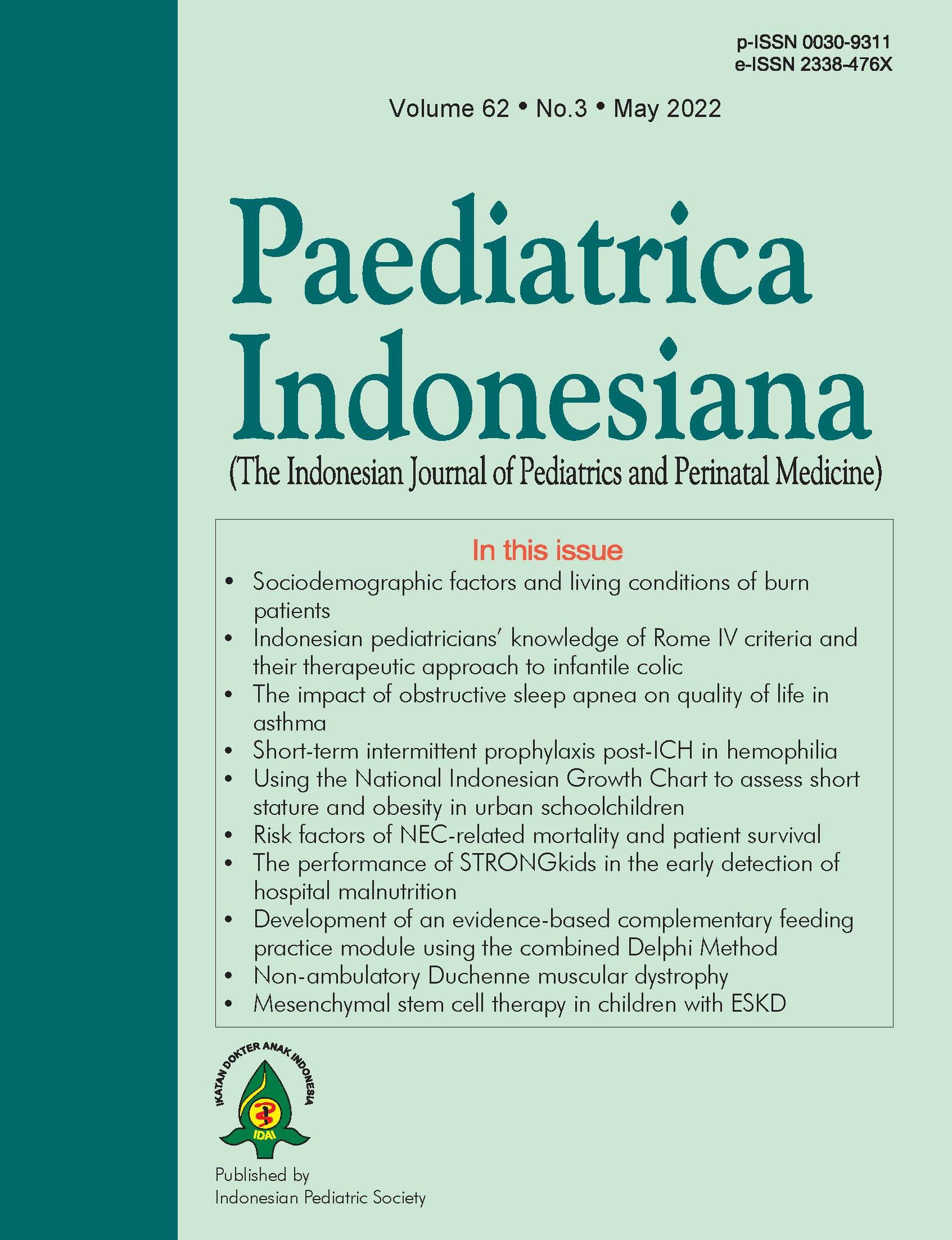Risk factors of necrotizing enterocolitis-related mortality in preterm neonates: a preliminary prospective study
Abstract
Background Necrotizing enterocolitis (NEC) is a prematurity-related complication of the gastrointestinal tract that affects 3-15% of preterm infants. Due to its atypical signs and symptoms, NEC is often diagnosed late, leading to mortality and morbidity.
Objective To describe the incidence, characteristics, and survival rate of preterm infants with NEC in the Neonatal Unit of Cipto Mangunkusumo Hospital.
Methods This prospective cohort study was conducted on preterm infants born in Cipto Mangunkusumo Hospital in 2019 who had NEC Bell stage 2 or higher. Subjects were recruited consecutively. NEC was classified into either early-onset (<14 days of life) or late-onset (?14 days of life). We identified the risk factors of mortality and survival using multiple Cox regression.
Results Within the study period, 55/639 preterm infants born in Cipto Mangunkusumo Hospital were diagnosed with NEC. Mean gestational age was 31.16 (SD 2.63) weeks and mean birth weight was 1,378.12 (SD 438.26) grams. The median age at NEC diagnosis was 6 (range 0-24) days. The most common symptoms were gastrointestinal bleeding (29.09%) and abdominal distension (29.09%). Plain abdominal radiographs showed dilated bowels in 92.72%, thickened intestinal walls in 83.63%, and pneumatosis intestinalis in 61.81% of subjects. Positive blood cultures were found in 63.63% of subjects, with Staphylococcus epidermidis and Klebsiella pneumoniae being the predominant organisms. Median survival was 27 days and 31 days for infants born at <32 weeks and ?32 weeks gestational age, respectively (P=0.37). Median survival was 27 and 28 days in infants with early-onset and late-onset NEC, respectively (P=0.07), and 23 and 28 days in infants with birth weight of <1,000 grams and ?1,000 grams, respectively (P=0.14).
Conclusion The incidence of NEC among preterm infants born in Cipto Mangunkusumo Hospital in 2019 was 8.6%. The survival rate of infants with NEC was 27.27%. Early-onset and late-onset NEC had similar mortality rates.
References
2. Battersby C, Santhalingam T, Costeloe K, Modi N. Incidence of neonatal necrotising enterocolitis in high-income countries: a systematic review. Arch Dis Child Fetal Neonatal Ed. 2018;103:F182-9. DOI: https://doi.org/10.1136/archdischild-2017-313880.
3. Kosloske AM. Epidemiology of necrotizing enterocolitis. Acta Paediatr Supple. 1994;396:2- 7. DOI: https://doi.org/10.1111/j.1651-2227.1994.tb13232.x.
4. Wójkowska-Mach J, Ró?a?ska A, Borszewska-Kornacka M, Doma?ska J, Gadzinowski J, Gulczy?ska E, et al. Necrotising enterocolitis in preterm infants: epidemiology and antibiotic consumption in the Polish neonatology network neonatal intensive care units in 2009. PLoS One. 2014;9e92865. DOI: https://doi.org/10.1371/journal.pone.0092865.
5. Li QY, An Y, Liu L, Wang XQ, Chen S, Wang ZL, et al. Differences in the clinical characteristics of early-and late-onset necrotizing enterocolitis in full-term infants: a retrospective case-control study. Scientific reports. 2017;7:1-7. DOI: https://doi.org/10.1038/srep43042.
6. Yee WH, Soraisham AS, Shah VS, Aziz K, Yoon W, Lee SK, et al. Incidence and timing of presentation of necrotizing enterocolitis in preterm infants. Pediatrics. 2012;129:e298-304. DOI: https://doi.org/10.1542/peds.2011-2022.
7. Snyder CL, Gittes GK, Murphy JP, Sharp RJ, Ashcraft KW, Amoury RA. Survival after necrotizing enterocolitis in infants weighing less than 1,000 g: 25 years' experience at a single institution. J Pediatr Surg. 1997:434-7. DOI: https://doi.org/10.1016/s0022-3468(97)90599-6.
8. Herrmann K, Carroll K. An exclusively human milk diet reduces necrotizing enterocolitis. Breastfeed Med. 2014;9:184-90. DOI: https://doi.org/10.1089/bfm.2013.0121.
9. Dong Y, Speer CP, Glaser K. Beyond sepsis: Staphylococcus epidermidis is an underestimated but significant contributor to neonatal morbidity. Virulence. 2018;9:621-33. DOI: https://doi.org/10.1080/21505594.2017.1419117.
Copyright (c) 2022 Risma Karina Kaban

This work is licensed under a Creative Commons Attribution-NonCommercial-ShareAlike 4.0 International License.
Authors who publish with this journal agree to the following terms:
Authors retain copyright and grant the journal right of first publication with the work simultaneously licensed under a Creative Commons Attribution License that allows others to share the work with an acknowledgement of the work's authorship and initial publication in this journal.
Authors are able to enter into separate, additional contractual arrangements for the non-exclusive distribution of the journal's published version of the work (e.g., post it to an institutional repository or publish it in a book), with an acknowledgement of its initial publication in this journal.

This work is licensed under a Creative Commons Attribution-NonCommercial-ShareAlike 4.0 International License.
Accepted 2022-06-21
Published 2022-06-21











